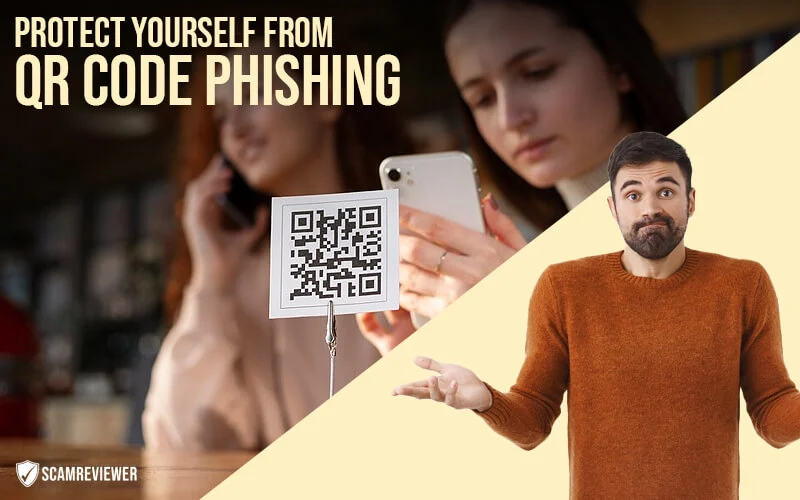What Is Quishing? Protect Yourself From QR Code Phishing

Ask anyone what phishing is, and they will say it relates to a scam based on emails. You may not be surprised, since these social engineering scams are common and their awareness around the globe is also prominent.
A few years ago, just before QR codes started to become popular and during the pandemic, the government requested that every citizen keep social distance. These QR codes became popular. Today, most of our transactions are paperless, and we heavily rely on these codes.
However, with such technology, scammers have used it to their advantage. They have started to scam many with this technology; sometimes even malware and viruses get downloaded.
What is a QR code?
A QR code is a kind of barcode that shows information. A QR code is designed as a barcode, which is square in nature. Unlike a barcode, which requires a barcode reader, these QR codes can be accessed through a smartphone’s camera.
These QR codes are linked to a website; thus, by scanning your smartphone’s camera, you get directed to a website, links to an app, payment gateway, pictures, a menu card, joining a WiFi network, and so forth.
As per research by Business Insider, more than 83.4 million US smartphone users scanned these QR codes in 2022. It has been estimated that these numbers will exceed 99.5 million by 2025.
What is Quishing?
As most of us are familiar with phishing, a kind of social engineering that involves emails, quishing is also a form of cybercrime that redirects its potential victim to malevolent sites or prompts them to download malicious software on their smartphones.
How does a Quishing attack look?
Post-pandemic, most of us are relying heavily on QR codes to complete a transaction. Scammers are on a quest to rip off as many victims as possible.
There are two types of Quishing attacks.
1 Physical Quishing Attacks
These exist in physical form, mostly in the form of a sticker that is placed over the original QR code. Such stickers are generally stuck in a parking meter, on the menu of a restaurant, hotel, gas station, and so forth.
2 Digital Quishing Attacks
These are represented as images that are received via email or message on social media platforms. You need to exercise caution while dealing with a QR code.
What happens during the Quishing attack?
When scanning a QR code in a Quishing attack, there are a few ways that this attack can result. We have listed a few that are common in our society.
- You scan for products, and when your payment gateway opens, it asks for your credentials, both the login credentials and the password. For a second, the screen blinks, and you think it is just a normal glitch. You then successfully complete the transaction. After some time, your financial holdings in the bank are all gone.
What happens is that during the time when the screen blinks, what you think is a glitch is that the scammers have cleverly embedded their QR code, and the payment gateway looks legit. While scanning, a fraudulent website opens, and when you type in your credentials, they get captured and sent to the scammers. Scammers, then, with these sensitive details, will transfer all the wealth from your bank account to theirs.
- Sometimes these scammers link these QR codes to a malicious website when the QR code is scanned. When these codes are scanned, they automatically download malicious software that will collect all the sensitive data on the smartphone and send it to the scammers. Thus, scammers can create mischief; they not only steal all your financial assets from your bank but also your crypto account if you have them.
Thus, with these sensitive details collected, you can be certain that you can also be targeted for another scam in the future due to identity theft.
How do you protect yourself from a Quishing attack?
It can be a tricky affair if you are in a hurry. Thus, you should always keep a cool head while you scan and look out for these telltale signs to detect a potential Quishing attack.
We have listed a few red flags to consider before you go ahead and complete what you may think is completing the transactions or joining a legitimate website.
Verifying and Authenticating if The Website is Legit
When you are paying the parking meter, make sure that there is no new sticker stuck on the original QR code on the card. You need to follow the same actions when you want to scan the QR code in a restaurant, gas station, motel, hotel, and so forth.
Use caution if you want to scan a QR code in an unfamiliar location. You should exercise the same caution when you want to purchase online mobile concert tickets, theater tickets, and so forth.
Sharing Information Online
One of the best ways to avoid a potential Quishing attack is to limit the information you want to share online. If a site is prompting you to type in all the sensitive details that are not normally required, then you can be sure that the site is being operated by a scammer.
It has become challenging to detect a phishing attack that is under the guise of a QR code, as these codes are popular in society. However, it is better to exercise caution than to proceed further.
Use Caution While Paying
Although paying off can be easy while using a QR code, it is equally dangerous to do so. Avoid using Venmo, PayPal, e-transfers, or debit cards that are not protected. It is always useful to opt for credit cards that guarantee consumer protection to safeguard your financial interests. Don’t allow a QR code interaction to divulge your private bank details or wire transfer payments.
Before Proceeding Further
When you hover your scanner over a QR code, a message appears that says the domain name of the site. Check carefully that there are no extra characters included in the message window before you proceed.
Having An Extra Layer of Security
Having a multi-authentication facilitator can also safeguard your financial holdings. Strong passwords and usernames are not as secure as these features, which offer an additional degree of security. However, you must approach a reputed and authentic firm that offers such multi-authentication features. These features are the best defense against phishing attacks.
Final Thoughts
We are so used to making payments using QR code features that it becomes challenging to deal with Quishing attacks; thus, we need to practice extra caution.


 1.6/5.0
1.6/5.0
 3.2/5.0
3.2/5.0 4.4/5.0
4.4/5.0
 2.8/5.0
2.8/5.0